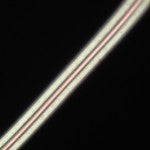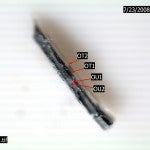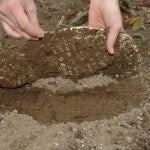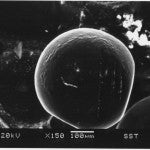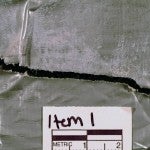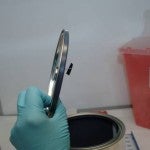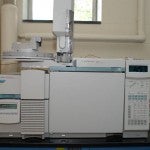The Trace Evidence Section of the Rhode Island State Crime Laboratory examines a wide range of evidence. Therefore, the trace evidence examiners must be proficient in several different techniques. In most cases, they examine evidence to determine whether it can be associated to a known source. Trace evidence examiners also assist with evidence collection when requested by local police or fire departments. Evidence examined in the Trace Evidence Section includes:
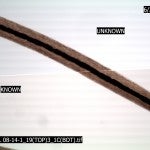 Hairs
Hairs
Most people naturally lose up to 100 head hairs per day. Because of this, there is ample opportunity for transfer of this material on to another person or surface at a crime scene. Examination of microscopic characteristics using a comparison microscope can associate a person to an unknown hair recovered from a scene or another person.
Fibers and Fabric
Fibers may be transferred in a variety of ways. Carpet fibers may be transferred to shoes as an individual walks across it or fibers from clothing may be transferred onto a vehicle when it strikes a pedestrian. Fibers may be compared using a comparison microscope. Additionally fiber types may be identified using a PLM and a FTIR. Fabrics may be examined to determine if damage present was caused by cutting, tearing or normal wear.
Paint
Paint can be transferred in many different ways. Paint can be transferred from one vehicle to another during a hit and run or onto a tool used to pry open a window. Instrumental analysis by microscopy, FTIR and SEM/EDS can determine the type of paint and conduct comparisons between known and unknown sources.
Impressions
Impressions can be made by footwear, tires, fabric, and tools. Unknown impressions can be examined to determine relevant manufacturer information, and comparisons to known sources can be conducted. If enough unique characteristics are present in an unknown impression, it can be identified to a specific source.
Gunshot Residue (GSR)
Items are examined for the presence of gunshot residue produced from the primer of a cartridge casing as a gun is fired. Examiners use the SEM/EDS to detect microscopic particles consistent in morphology and elemental composition with GSR particles.
Physical Match
When an object is broken, torn, or cut, unique edges may be formed. By examining those edges macroscopically and microscopically, the edges may be fit together like puzzle pieces. If the edges can be fit together, it can be said that they were at one time a single object. Car parts, tape, fabric, and glass are just a few of the many types of evidence where a physical match can be achieved.
Fire Debris
When a suspicious fire occurs, specially trained investigators will examine the scene. If they suspect that an accelerant may have been used, evidence is collected and brought to the lab. A GC/MS is used to determine the presence or absence of petroleum products and non-petroleum based accelerants.
Miscellaneous examinations
When a piece of evidence is brought to the laboratory and no other units are able to analyze it, the Trace Evidence Section will often receive the evidence and attempt to identify it through the use of numerous microscopic and chemical analyses and compare it to a known source, if available. Potentially, every piece of instrumentation in the section may be used to analyze the material. Examples of this type of evidence include: pepper sprays or maces, acid/foil bottle bombs, exploding bank dye packs, general unknowns, lamp filaments and pressure sensitive tapes.
Equipment
The Trace Evidence Section uses many types of equipment to analyze evidence including a Stereomicroscope, Polarized Light Microscope (PLM), Comparison Microscope, Fourier Transform Infrared Spectrophotometer (FTIR), Scanning Electron Microscopy/Energy Dispersive Spectrometer (SEM/EDS) and Gas Chromatograph/Mass Spectrometer (GC/MS).
 URI Homepage
URI Homepage




